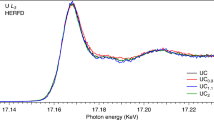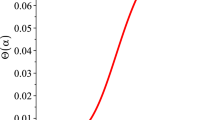Abstract
URANIUM carbide has assumed importance recently as a cathode material for use in a thermionic converter. In this context it combines the advantage of stability in an atmosphere of cæsium (though recent American reports indicate that this may not be the case), which will probably be required for the neutralization of space charge, with the possibility of fission heating in a neutron flux. Uranium carbide has been claimed to have good emission properties and at least two attempts have been made to determine the thermionic constants1,2. Work functions of 4.57 and 2.94 eV. have been reported; the former for bulk uranium carbide1, the latter for the powder deposited on a tungsten filament2. In both cases high accelerating potentials were used and the zero field emission was determined by the extrapolation of the linear region of a Schottky plot which is found at the highest fields. The application of Richardson's equation then produced the work functions detailed here. Criticism of most of the standard techniques for the measurement of work function is not difficult to produce, especially when patchy cathodes are involved3,4. The aim of the present work, part of which is described in this communication, is to use a technique which is subject to fewer objections than can be raised against the previous measurements of the work function of uranium carbide. To this end, the Zisman modification of the Kelvin vibrating condenser technique has been applied to measure the contact potential difference between a clean tungsten reference surface and the uranium carbide cathode.
This is a preview of subscription content, access via your institution
Access options
Subscribe to this journal
Receive 51 print issues and online access
$199.00 per year
only $3.90 per issue
Buy this article
- Purchase on Springer Link
- Instant access to full article PDF
Prices may be subject to local taxes which are calculated during checkout
Similar content being viewed by others
References
Pidd, R. W., Grover, P. M., Roehling, D. J., Salmi, E. W., Farr, J. D., Krikorian, N. H., and Witteman, W. G., J. App. Phys., 30, 1575 (1959).
Haas, G. A., and Jensen, J. T., J. App. Phys., 31, 1231 (1960).
Herring, C., and Nichols, Rev. Mod. Phys., 21, 185 (1949).
Herrmann, C., and Wagener, S., The Oxide Coated Cathode, 2 (Chapman and Hall, Ltd., London, 1951).
Venema, A., and Bandringa, M., Philips Tech. Rev., 20, 145 (1958–59).
Dushman, S., Rowe, H. M., Ewald, J., and Kidner, C. A., Phys. Rev., 25, 338 (1925).
Anderson, P. A., Phys. Rev., 47, 958 (1935).
Author information
Authors and Affiliations
Rights and permissions
About this article
Cite this article
HOPKINS, B. Work Function of Uranium Carbide. Nature 193, 668–669 (1962). https://doi.org/10.1038/193668a0
Issue Date:
DOI: https://doi.org/10.1038/193668a0
Comments
By submitting a comment you agree to abide by our Terms and Community Guidelines. If you find something abusive or that does not comply with our terms or guidelines please flag it as inappropriate.



